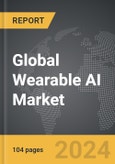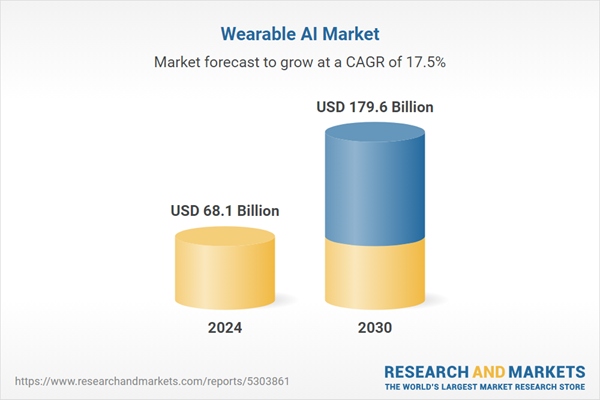The global market for Wearable AI was valued at US$68.1 Billion in 2024 and is projected to reach US$179.6 Billion by 2030, growing at a CAGR of 17.5% from 2024 to 2030. This comprehensive report provides an in-depth analysis of market trends, drivers, and forecasts, helping you make informed business decisions. The report includes the most recent global tariff developments and how they impact the Wearable AI market.
The integration of AI into wearable technology holds immense promise for enhancing functionality and user experience. Overcoming current challenges related to data standardization, privacy, and battery life will be crucial for realizing this potential. The growth of wearable AI is primarily driven by advancements in AI and machine learning technologies, increased consumer health awareness, and the proliferation of connected devices within the Internet of Things (IoT) ecosystem. As AI algorithms become more sophisticated, they enable wearables to offer more precise and personalized health and fitness recommendations. Additionally, the growing awareness and emphasis on health and wellness have led consumers to adopt wearable devices that can monitor vital signs, physical activity, and even mental well-being. This trend is further supported by the increasing integration of wearables with IoT, allowing seamless connectivity and data sharing across multiple devices and platforms, thus enhancing the overall user experience.
The convergence of AI and wearable technology is a significant advancement towards a patient-centered, proactive, and accessible healthcare system. By leveraging these technologies, healthcare organizations can gain a competitive edge and improve the quality of care they provide. Furthermore, the development of more energy-efficient and miniaturized AI chips is enabling the creation of sleeker and more powerful wearables. AI-powered wearables have diverse applications in healthcare, including chronic disease management, elderly care, rehabilitation and physical therapy, mental health monitoring, remote patient monitoring, and personalized health and wellness. These devices assist in managing chronic conditions by continuously monitoring vital signs and providing personalized health insights. In elderly care, AI wearables monitor vital signs and activity levels, enabling timely interventions and enhancing the quality of life for seniors. In rehabilitation and physical therapy, wearables track movement and provide real-time feedback, aiding recovery from injuries and surgeries. Mental health monitoring is facilitated by AI wearables that track physiological and behavioral indicators, offering valuable insights for early intervention and support. As privacy and data security concerns grow, there is also a trend towards implementing more robust security measures and data encryption techniques in wearable AI devices to protect user information.
Segments: Product Type (Smartwatches, Fitness Trackers, Smart Earwear, AR/VR Headsets, Other Product Types); Application (Consumer Electronics Application, Healthcare Application, Enterprise & Industrial Application, Other Applications).
Geographic Regions/Countries: World; United States; Canada; Japan; China; Europe (France; Germany; Italy; United Kingdom; and Rest of Europe); Asia-Pacific; Rest of World.
The analysts continuously track trade developments worldwide, drawing insights from leading global economists and over 200 industry and policy institutions, including think tanks, trade organizations, and national economic advisory bodies. This intelligence is integrated into forecasting models to provide timely, data-driven analysis of emerging risks and opportunities.
Global Wearable AI Market - Key Trends and Drivers Summarized
Wearable AI refers to the integration of artificial intelligence (AI) technologies into wearable devices such as smartwatches, fitness trackers, smart glasses, and other portable gadgets. These devices leverage AI to offer advanced functionalities including health monitoring, activity tracking, personalized notifications, and even augmented reality experiences. The AI component enables these wearables to learn from user data, provide personalized insights, and improve over time, thereby enhancing user experience and engagement.The integration of AI into wearable technology holds immense promise for enhancing functionality and user experience. Overcoming current challenges related to data standardization, privacy, and battery life will be crucial for realizing this potential. The growth of wearable AI is primarily driven by advancements in AI and machine learning technologies, increased consumer health awareness, and the proliferation of connected devices within the Internet of Things (IoT) ecosystem. As AI algorithms become more sophisticated, they enable wearables to offer more precise and personalized health and fitness recommendations. Additionally, the growing awareness and emphasis on health and wellness have led consumers to adopt wearable devices that can monitor vital signs, physical activity, and even mental well-being. This trend is further supported by the increasing integration of wearables with IoT, allowing seamless connectivity and data sharing across multiple devices and platforms, thus enhancing the overall user experience.
The convergence of AI and wearable technology is a significant advancement towards a patient-centered, proactive, and accessible healthcare system. By leveraging these technologies, healthcare organizations can gain a competitive edge and improve the quality of care they provide. Furthermore, the development of more energy-efficient and miniaturized AI chips is enabling the creation of sleeker and more powerful wearables. AI-powered wearables have diverse applications in healthcare, including chronic disease management, elderly care, rehabilitation and physical therapy, mental health monitoring, remote patient monitoring, and personalized health and wellness. These devices assist in managing chronic conditions by continuously monitoring vital signs and providing personalized health insights. In elderly care, AI wearables monitor vital signs and activity levels, enabling timely interventions and enhancing the quality of life for seniors. In rehabilitation and physical therapy, wearables track movement and provide real-time feedback, aiding recovery from injuries and surgeries. Mental health monitoring is facilitated by AI wearables that track physiological and behavioral indicators, offering valuable insights for early intervention and support. As privacy and data security concerns grow, there is also a trend towards implementing more robust security measures and data encryption techniques in wearable AI devices to protect user information.
Report Scope
The report analyzes the Wearable AI market, presented in terms of units. The analysis covers the key segments and geographic regions outlined below.Segments: Product Type (Smartwatches, Fitness Trackers, Smart Earwear, AR/VR Headsets, Other Product Types); Application (Consumer Electronics Application, Healthcare Application, Enterprise & Industrial Application, Other Applications).
Geographic Regions/Countries: World; United States; Canada; Japan; China; Europe (France; Germany; Italy; United Kingdom; and Rest of Europe); Asia-Pacific; Rest of World.
Key Insights:
- Market Growth: Understand the significant growth trajectory of the Smartwatches segment, which is expected to reach US$92.5 Billion by 2030 with a CAGR of a 19.0%. The Fitness Trackers segment is also set to grow at 17.5% CAGR over the analysis period.
- Regional Analysis: Gain insights into the U.S. market, valued at $18.2 Billion in 2024, and China, forecasted to grow at an impressive 16.3% CAGR to reach $27.2 Billion by 2030. Discover growth trends in other key regions, including Japan, Canada, Germany, and the Asia-Pacific.
Why You Should Buy This Report:
- Detailed Market Analysis: Access a thorough analysis of the Global Wearable AI Market, covering all major geographic regions and market segments.
- Competitive Insights: Get an overview of the competitive landscape, including the market presence of major players across different geographies.
- Future Trends and Drivers: Understand the key trends and drivers shaping the future of the Global Wearable AI Market.
- Actionable Insights: Benefit from actionable insights that can help you identify new revenue opportunities and make strategic business decisions.
Key Questions Answered:
- How is the Global Wearable AI Market expected to evolve by 2030?
- What are the main drivers and restraints affecting the market?
- Which market segments will grow the most over the forecast period?
- How will market shares for different regions and segments change by 2030?
- Who are the leading players in the market, and what are their prospects?
Report Features:
- Comprehensive Market Data: Independent analysis of annual sales and market forecasts in US$ Million from 2024 to 2030.
- In-Depth Regional Analysis: Detailed insights into key markets, including the U.S., China, Japan, Canada, Europe, Asia-Pacific, Latin America, Middle East, and Africa.
- Company Profiles: Coverage of players such as Amazon, Apple, Atlas, Biobeats, Bragi and more.
- Complimentary Updates: Receive free report updates for one year to keep you informed of the latest market developments.
Some of the 64 companies featured in this Wearable AI market report include:
- Amazon
- Apple
- Atlas
- Biobeats
- Bragi
- Fitbit
- Focusmotion
- Garmin
- Huawei
Tariff Impact Analysis: Key Insights for 2025
Global tariff negotiations across 180+ countries are reshaping supply chains, costs, and competitiveness. This report reflects the latest developments as of April 2025 and incorporates forward-looking insights into the market outlook.The analysts continuously track trade developments worldwide, drawing insights from leading global economists and over 200 industry and policy institutions, including think tanks, trade organizations, and national economic advisory bodies. This intelligence is integrated into forecasting models to provide timely, data-driven analysis of emerging risks and opportunities.
What’s Included in This Edition:
- Tariff-adjusted market forecasts by region and segment
- Analysis of cost and supply chain implications by sourcing and trade exposure
- Strategic insights into geographic shifts
Buyers receive a free July 2025 update with:
- Finalized tariff impacts and new trade agreement effects
- Updated projections reflecting global sourcing and cost shifts
- Expanded country-specific coverage across the industry
Table of Contents
I. METHODOLOGYII. EXECUTIVE SUMMARY2. FOCUS ON SELECT PLAYERSIII. MARKET ANALYSISIV. COMPETITION
1. MARKET OVERVIEW
3. MARKET TRENDS & DRIVERS
4. GLOBAL MARKET PERSPECTIVE
UNITED STATES
CANADA
JAPAN
CHINA
EUROPE
FRANCE
GERMANY
ITALY
UNITED KINGDOM
REST OF EUROPE
ASIA-PACIFIC
REST OF WORLD
Companies Mentioned (Partial List)
A selection of companies mentioned in this report includes, but is not limited to:
- Amazon
- Apple
- Atlas
- Biobeats
- Bragi
- Fitbit
- Focusmotion
- Garmin
- Huawei
Table Information
| Report Attribute | Details |
|---|---|
| No. of Pages | 104 |
| Published | April 2025 |
| Forecast Period | 2024 - 2030 |
| Estimated Market Value ( USD | $ 68.1 Billion |
| Forecasted Market Value ( USD | $ 179.6 Billion |
| Compound Annual Growth Rate | 17.5% |
| Regions Covered | Global |









